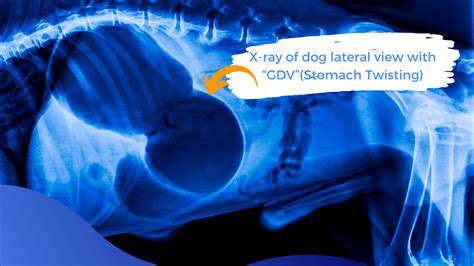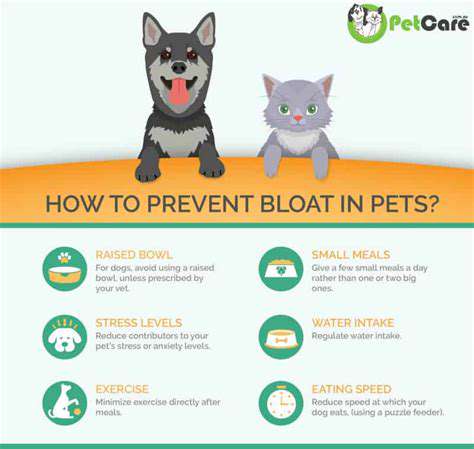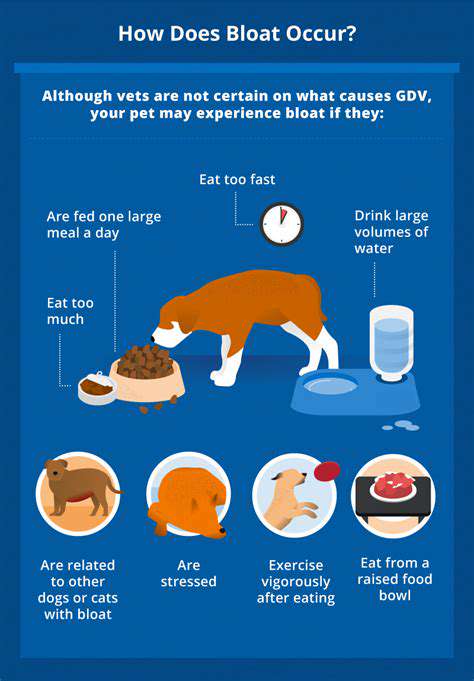Understanding Canine Bloat: Prevention and Emergency
What is Canine Bloat (GDV)?

What is Canine Bloat (GDV)?
Canine bloat, also known as gastric dilatation-volvulus (GDV), is a life-threatening condition in dogs characterized by a rapid and dangerous expansion of the stomach with gas. This condition is a veterinary emergency, and prompt treatment is crucial for the dog's survival. The stomach can become severely distended, putting pressure on vital organs and potentially twisting the stomach. This twist, known as volvulus, restricts blood flow to the affected area, leading to shock and other serious complications.
Recognizing the symptoms of GDV is vital for timely intervention. Early detection can significantly improve the chances of a positive outcome. Failure to act quickly can result in irreversible damage to the dog's internal organs and even death.
Causes of Canine Bloat
While the exact cause of GDV is still not fully understood, several factors are believed to contribute to its development. These include rapid consumption of large meals, especially after strenuous exercise or water consumption. This rapid intake of food and water can quickly fill the stomach with gas and potentially lead to the expansion and twisting of the stomach.
Certain breeds are more prone to GDV than others. Deep-chested breeds, such as Great Danes, German Shepherds, and Dobermans, are at a higher risk due to their anatomical predisposition. However, any dog can be affected.
Symptoms of Canine Bloat
The symptoms of GDV can vary, but some common signs include excessive panting, restlessness, drooling, and abdominal distension. The dog may also exhibit signs of pain, such as whimpering or restlessness. These symptoms are often subtle initially, making early detection challenging for pet owners.
Other symptoms include pale gums, a weak pulse, and difficulty breathing. These symptoms are often noticeable as the condition progresses. If you observe any of these signs in your dog, seek immediate veterinary care.
Risk Factors for Canine Bloat
Several factors can increase a dog's risk of developing GDV. These factors include breed predisposition, large meal consumption, strenuous activity, and certain dietary habits. A dog's breed plays a significant role, as some breeds have a greater likelihood of developing GDV. Factors such as obesity and age can also increase a dog's risk.
Diagnosis of Canine Bloat
Veterinary professionals utilize various diagnostic methods to confirm a GDV diagnosis. These methods often include a thorough physical examination, including checking for abdominal distension and assessing the dog's vital signs. Blood tests, radiographs, and ultrasound imaging may also be used to provide a clearer picture of the condition.
Treatment for Canine Bloat
Treatment for GDV typically involves immediate surgical intervention. The surgery aims to correct the twisting of the stomach and relieve the pressure on the surrounding organs. This procedure, performed under anesthesia, is often time-sensitive and requires careful attention to detail. The goal is to restore blood flow to the affected areas and stabilize the dog's vital functions.
Prevention of Canine Bloat
While not all cases of GDV can be prevented, several strategies can help minimize the risk. These include feeding smaller, more frequent meals, avoiding strenuous exercise immediately before or after meals, and ensuring access to fresh water. Slowing down the rate of food consumption is often a key strategy for lowering the risk of GDV.
Preventing Canine Bloat

Understanding Canine Bloat
Canine bloat, also known as gastric dilatation-volvulus (GDV), is a life-threatening condition affecting dogs, primarily large and deep-chested breeds. It's characterized by the rapid expansion of the stomach with gas or fluid, which can then twist (volvulus), cutting off blood supply to vital organs. This twisting, or volvulus, is a critical aspect of the condition, as it dramatically increases the risk of severe complications and death.
Recognizing the symptoms of bloat is crucial for prompt veterinary intervention. Early diagnosis and treatment greatly improve the chances of survival for affected dogs.
Identifying the Symptoms of Bloat
The initial symptoms of bloat can be subtle, making early detection challenging. Dogs may exhibit restlessness, excessive panting, and discomfort in the abdomen. These initial signs are important to note, as they can be early indicators of the condition. The dog may also appear weak or have difficulty breathing.
As the condition progresses, more pronounced symptoms emerge. These include a distended abdomen, drooling, and pale gums. These are clear signs that the animal is in distress, and immediate veterinary attention is needed.
Risk Factors for Canine Bloat
Certain breeds, such as Great Danes, German Shepherds, and Irish Wolfhounds, are predisposed to bloat due to their deep chests and large size. Rapid eating habits, especially after intense exercise or a large meal, can also increase the risk. A large meal can cause a significant increase in gas production and put pressure on the stomach.
Other factors that can contribute to the risk include exercising after eating, eating large quantities, and certain types of food or diets.
Dietary Considerations to Prevent Bloat
Feeding dogs smaller, more frequent meals, rather than one large meal, is often recommended. This approach helps to reduce the volume of food in the stomach at any given time. This is a critical dietary adjustment to reduce pressure and strain on the stomach.
Avoiding highly stimulating foods, such as table scraps or high-fat treats, can also help to reduce the risk of bloat. A balanced diet tailored to the dog's breed and size is essential to maintain optimal health.
Preventive Measures and Management
Feeding a diet specifically formulated for bloat prevention is another valuable strategy. Such diets often contain ingredients that help to reduce gas formation and promote healthy digestion. Regular veterinary check-ups are crucial for early detection and prevention of bloat.
Owners should also be vigilant about recognizing subtle changes in their dog's behavior and seek immediate veterinary care if any of the listed symptoms are observed.
The Importance of Early Veterinary Intervention
Prompt veterinary intervention is crucial for the survival of a dog experiencing bloat. Early treatment can significantly increase the chances of recovery. Treatment typically involves immediate stabilization and addressing the stomach twisting. Delay in treatment can significantly impact the dog's prognosis.
Veterinary care includes administering intravenous fluids, administering medications, and potentially surgery to correct the stomach torsion. This is a serious and potentially fatal condition requiring immediate attention.
Recognizing the Signs of Canine Bloat

Early Warning Signs
Identifying the early signs of canine illness is crucial for prompt veterinary intervention and maximizing your pet's chances of a full recovery. Early detection often leads to more effective treatment and a better prognosis. Pay close attention to subtle changes in your dog's behavior, such as lethargy, loss of appetite, or changes in drinking habits. These seemingly minor shifts can be indicative of underlying issues.
Changes in elimination patterns, such as straining to urinate or defecate, or altered frequency, can also signal a problem. Be vigilant about noting any unusual discharge from the nose or eyes, or any observable swelling or redness on the skin. These subtle cues can be the first hints of potential illness.
Physical Examination Clues
A thorough physical examination is often the first step in identifying potential canine health issues. A veterinarian's keen eye can detect subtle signs that might be missed by the untrained eye. Indicators like a rapid or irregular heartbeat, labored breathing, or unusual body temperature (too high or too low) can reveal underlying illnesses.
Assessing your dog's overall body condition, including muscle mass, hydration levels, and any visible lumps or bumps, is also vital. Changes in these parameters can signal potential problems, from infections to more serious conditions. Observing your dog's posture and mobility is equally important, as limping, stiffness, or difficulty moving can indicate joint issues or other musculoskeletal problems.
Behavioral Changes
Beyond the physical, canine behavior can dramatically shift when they're unwell. Noticeable changes in personality, such as becoming unusually withdrawn or aggressive, can be significant indicators of potential illness. Changes in activity levels, from excessive sleeping to sudden hyperactivity, should also be carefully observed. A dog that is normally playful might become lethargic or refuse to engage in their usual activities.
Changes in appetite and water intake are also important behavioral signs. A dog that suddenly loses their appetite or drastically changes their water intake habits might be experiencing underlying health problems. Even seemingly minor shifts in these behaviors warrant careful monitoring and potential veterinary consultation.
Dietary Considerations
Diet plays a crucial role in maintaining canine health. A dog's dietary needs change based on age, breed, and activity level. Ensuring your dog is receiving a nutritionally balanced diet is essential for preventing many health issues. Sudden changes in eating habits, such as refusing food or showing an unusually strong interest in inappropriate items, should raise concerns and warrant investigation.
Monitor your dog's weight and adjust their food intake accordingly as needed. A sudden significant weight gain or loss can also be a sign of underlying problems and should prompt a veterinary visit. Providing a consistent, high-quality diet tailored to your dog's specific needs can significantly contribute to their overall well-being and reduce the risk of many health issues.
Read more about Understanding Canine Bloat: Prevention and Emergency
Hot Recommendations
- Best Pet Bowls: Stainless Steel and Ceramic
- Pet Hydration: Why It's Crucial
- Stop Counter Surfing: Training Your Dog to Stay Off
- Pet Hypothyroidism: Symptoms and Management
- Signs of Pet Liver Disease: What to Watch For
- Pet Emergency Kits: What to Pack
- Dangers of Xylitol: Toxic to Dogs
- Dealing with Pet Diarrhea: When to See a Vet
- Preparing Pets for Travel: Tips for a Smooth Trip
- Pet Depression: Recognizing the Signs